Biostatistician joins the Strategic COVID-19 Public Health Advisory Group
29 April 2021
A strategic public health advisory group has been set up to provide independent advice and analysis to the Government, informed by their expertise in epidemiology, infectious diseases, public health, and modelling on these future decisions.
The Government will be seeking their advice on issues such as how much of our population needs to be vaccinated before we can relax our border settings, evidence for transmission blocking properties of the vaccine, strategic public health controls when the borders reopen and public health responses to any new variants that aren't covered by our current vaccine options.
The Ministry of Health will support the Group's work and share any information that would be useful to them. The Group will work alongside Sir Brian Roche's COVID-19 Independent Continuous Review, Improvement and Advice Group, especially around health protections post vaccine.
The members will also have a public facing role. Once advice has been considered, they will need to communicate the science behind any changes to New Zealand's border settings.
The Group will report to the Minister for COVID-19 Response, Chris Hipkins via Associate Minister of Health (Public Health) Dr Ayesha Verrall, who will be meeting the members regularly.
The Group is chaired by Professor Sir David Skegg, and is made up of the following members:
- Associate Professor Nikki Turner
- Professor Philip Hill
- Dr Maia Brewerton
- Professor David Murdoch
- Dr Ella Iosua
- Rodney Jones (Special Advisor)
- Shaun Hendy (Special Advisor)
- Observer: Dr Ian Town
Additional information
Biostatistics Centre in the Otago Museum's Reverse Science Fair
26 February 2021
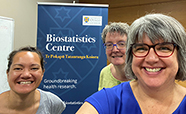 Associate Professor Robin Turner, Dr Claire Cameron and Dr Ella Iosua, with support from Elise Velenski, represented the Biostatistics Centre in the Otago Museum's reverse science fair with two hands-on activities for attendees. Our arm span versus height activity generated some interesting discussions, particularly when we asked people if they would get a different answer if they repeated the measurements. We enjoyed meeting lots of people and hearing about their interest in science, and we were also fascinated by the other activities showcased in the fair.
Associate Professor Robin Turner, Dr Claire Cameron and Dr Ella Iosua, with support from Elise Velenski, represented the Biostatistics Centre in the Otago Museum's reverse science fair with two hands-on activities for attendees. Our arm span versus height activity generated some interesting discussions, particularly when we asked people if they would get a different answer if they repeated the measurements. We enjoyed meeting lots of people and hearing about their interest in science, and we were also fascinated by the other activities showcased in the fair.
Thank you to the Otago Museum for inviting us to be part of this event and looking after us so well.
Thanks also to Dr Michelle Dalrymple, Head of Faculty, Mathematics & Statistics, Cashmere High School, for all your help with the planning for this event.
Canine Levi is sniffing out bowel cancer in saline
15 December 2020
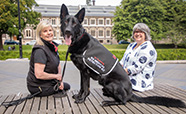 After less than a year of training, German shepherd Levi is successfully sniffing out bowel cancer cells in saline.
After less than a year of training, German shepherd Levi is successfully sniffing out bowel cancer cells in saline.
The University of Otago and K9 Medical Detection NZ are working together on New Zealand-first research to investigate using dogs as a diagnostic tool to sniff out bowel cancer – one of New Zealand's most commonly diagnosed cancers.
According to the Bowel Cancer Foundation Trust, New Zealand can expect more than 3,000 people to be diagnosed with bowel cancer each year, with about 1,200 dying from it. It says 90 per cent of people can be saved if it's detected early enough.
Medical detection dogs, such as Levi, are trained to identify volatile organic compounds which are released from tumours present in medical conditions, such as cancer.
When it comes to detecting cancer, there is growing evidence that elevated levels of volatile organic compounds are associated with disease growth. Research has shown that dogs can be trained to detect these odours and identify the “signature smell” associated with cancer.
K9 Medical Detection NZ founder and director Pauline Blomfield says the results from the first stage are “highly exciting”.
“Despite the disruption caused throughout the year by the COVID-19 pandemic, the data recorded from K9 Levi's odour work conclusively proves this working-line dog can detect various odour concentration levels of bowel cancer in saline,” she says.
“This success confirms our training methodologies and gives confidence for year two of this trial to repeat the process with the bowel cancer samples in urine.”
Levi has completed the initial scent imprinting training, during which time his trainer, Courtney Moore, pairs the positive cancer sample with reward using positive reinforcement and specific training methodology. Levi is still in training but is detecting positive cancer samples 92.8 per cent of the time, and ignoring samples that did not contain cancer 99.8 percent of the time.
“In New Zealand 23 people die from bowel cancer every week. My vision of creating a simple, non-invasive urine test for early detection of bowel cancer is now one step closer,” Blomfield says.
Otago's Biostatistics Centre Director Associate Professor Robin Turner says the training results are “very promising”. The next step is validation; an experimental design in which the trainer also does not know whether the test samples are positive or negative for cancer. This ensures she is not influencing the results.
“These validation studies are what are required to show the test has high diagnostic accuracy.”
There will be a series of validation studies conducted; moving from using the current lab-grown cancer cells in saline to lab-grown urine and then finally to real patient samples.
“At each step of the way we will need to assess the accuracy both in terms of the science but also it provides feedback for the training,” Associate Professor Turner says.
“Levi is responding exceptionally well to the training and I'm very positive that the validation will show he has high accuracy.”
Bowel Cancer Foundation Trust CEO and Founder Georgina Mason, who initiated the project, is “blown away” by Levi's achievements so far.
“While medical detection dogs aren't a new phenomena, bowel cancer has never been detected in urine before. Only recently, researchers have found bio markers in urine which we believe the detection dogs are able to pick up on.
“We are really excited about these recent results and expect Levi to be able to replicate them replacing saline with urine from January. When he is able to do that, this research will be a world first and help put New Zealand at the forefront of bowel cancer detection.
“We believe if we can develop a highly accurate urine test using canine detection to help diagnose early stage bowel cancer, we can push those patients likely to have bowel cancer to the front of the colonoscopy queue and help save lives.”
Levi will soon be joined in his cancer-detection training by 16-month-old German shepherd, Weta.
“I am blown away by Levi's achievements and am very encouraged by the hard work he and Pauline's team have accomplished so far. Together we are all working hard to make a difference for bowel cancer patients in New Zealand and around the world,” Mason says.
Read more about Levi at the Otago Daily Times
More than just a name change
4 November 2020
The name change for what is now called the Biostatistics Centre may be subtle, but it comes with important structural moves.
While the roll out of the new name for what was the Centre for Biostatistics has gone largely unnoticed, Centre Director Associate Professor Robin Turner says it represents an important structural change that “has taken a while to implement”.
While there have been biostatisticians in the Health Sciences Division across the three campuses for many decades, the first “version” of the Centre came into existence in 2017.
Prior to November 2017, the biostatisticians were in the Department of Preventive and Social Medicine. The first “version” of the Centre was managed in the Dunedin School of Medicine's Dean's Department, but the focus of the group is to collaborate with health researchers across the whole division. So, in 2018 it moved to the divisional office to better reflect its reach across the Division.
“The paperwork took a little longer, actually a lot longer, and as of the 1st of September 2020, this became formalised as the Biostatistics Centre; an independent academic Centre that reports directly to the PVC Health Sciences,” Associate Professor Turner says.
“Now that we are a Centre, we are able to raise our profile so that researchers can work collaboratively with us. Our key message to any researchers who would like to work with us is to talk to us as early in the research process as possible.
“We are always very interested in hearing about new research and can, from the beginning, contribute to the development of the project. Collaborating with us from the very beginning leads to improved research quality.”
The Biostatistics Centre also offers a PhD in Biostatistics.
Articles in the New Zealand Medical Student Journal
29 July 2020
Members of the Biostatistics Centre currently have the following articles featured in the New Zealand Medical Student Journal.
Kaplan-Meier plots – Issue 28
Understanding receiver operator characteristic (ROC) curves – Issue 29
Parametric vs nonparametric statistical methods: which is better, and why? – Issue 30
P-values: what is their significance? – Issue 31
Sample size in health research – Issues 32
Biostatistician contributes to NZ soldiers suffering post-traumatic stress disorder research
24 April 2020
Dr Ari Samaranayaka from the Centre for Biostatistics was the lead biostatistician on a project that recently attracted media attention. In TV1 news on 24th April, Associate Professor David McBride described findings of a comprehensive survey by Otago researchers that examined post-traumatic stress disorder among serving and retired New Zealand military personnel. Ari contributed to the study design, analyses, interpretation and dissemination of this study. Congratulations Ari on your contributions to such an important piece of research!
Download the published research article (PDF)
Consent has been given by Associate Professor David McBride to promote this research on our website.
Regression modelling course
28 and 29 November 2019
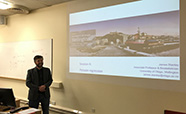 On the 28th and 29th of November 2019, Associate Professor James Stanley came down from the Wellington campus to run a two-day workshop on regression. We covered simple linear, multiple linear, logistic and poisson regression. There was even time for some talk of model selection and functional forms. It was a thoroughly enjoyable time for all involved (or so we believe). A number of biostatisticians also joined in which lead to some interesting discussions in class. The attendees were very engaged with the subject and, as always, the food was outstanding!
On the 28th and 29th of November 2019, Associate Professor James Stanley came down from the Wellington campus to run a two-day workshop on regression. We covered simple linear, multiple linear, logistic and poisson regression. There was even time for some talk of model selection and functional forms. It was a thoroughly enjoyable time for all involved (or so we believe). A number of biostatisticians also joined in which lead to some interesting discussions in class. The attendees were very engaged with the subject and, as always, the food was outstanding!
New Zealand Statistics Association conference
28 November 2019
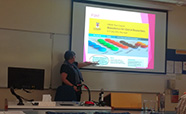 Recently the Director of the Centre, Robin Turner, presented at the New Zealand Statistics Association conference, held in Dunedin. Her presentation was about teaching biostatistics to clinical researchers. This is based on her experience running the Introductory Biostatistics workshops.
Recently the Director of the Centre, Robin Turner, presented at the New Zealand Statistics Association conference, held in Dunedin. Her presentation was about teaching biostatistics to clinical researchers. This is based on her experience running the Introductory Biostatistics workshops.
Check out the Centre's workshop programme here
Mid-winter Biostatistics get together
11 September 2019
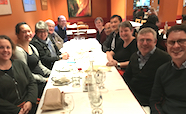 On July 31, as a mid-winter pick-me-up, many in the Centre for Biostatistics (Claire, Jill, Ella, Robin, Ari and, honorarily, Jimmy) went out for a Turkish meal at Paasha (a Dunedin restaurant). Several of our Mathematics and Statistics friends joined us (Peter Dillingham, Matt Parry and John Harraway). We had a grand old time. It was lovely to have some partners come along also (Christina, Andy and Rua (photographer).
On July 31, as a mid-winter pick-me-up, many in the Centre for Biostatistics (Claire, Jill, Ella, Robin, Ari and, honorarily, Jimmy) went out for a Turkish meal at Paasha (a Dunedin restaurant). Several of our Mathematics and Statistics friends joined us (Peter Dillingham, Matt Parry and John Harraway). We had a grand old time. It was lovely to have some partners come along also (Christina, Andy and Rua (photographer).
Master of Public Health (MPH) candidate achieves distinction
18 July 2019
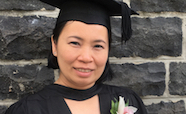 Warinthon Baker talks about her experience of having biostatistical expertise in her supervisory team from the early phase of her research design. She went on to achieve distinction for her thesis.
Warinthon Baker talks about her experience of having biostatistical expertise in her supervisory team from the early phase of her research design. She went on to achieve distinction for her thesis.
"Superb guidance from my wonderful supervisory team prepared me to be fortunate enough to graduate with a distinction, and to publish a first-author paper in a reputed international journal."
Read Warinthon's testimonial
Biostatistics reveals surge in Legionnaires' disease
24 June 2019
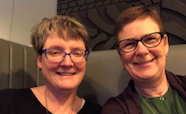
Senior Research Fellow Claire Cameron with first author Associate Professor Patricia Priest.
Senior Research Fellow Claire Cameron was the biostatistician on a national surveillance study that found that there are three times as many cases of Legionnaires' disease in New Zealand as previously reported.
Her contribution included input through the data collection process through to revisions of the manuscripts. The analysis required the calculation of age-standardised rates which required combining information gathered from the national study with data obtained from Statistics New Zealand.
The work was published in The Lancet Infectious Diseases on June 11, 2019: The burden of Legionnaires' disease in New Zealand (LegiNZ): a national surveillance study_
Read more in the media release:
Researchers find triple as many Legionnaires' cases as previously reported